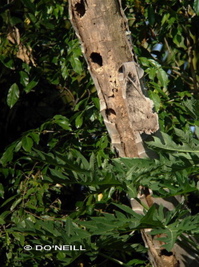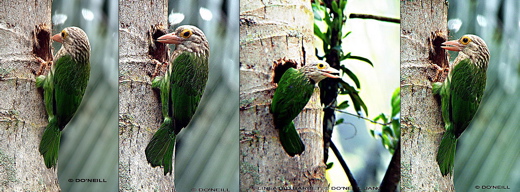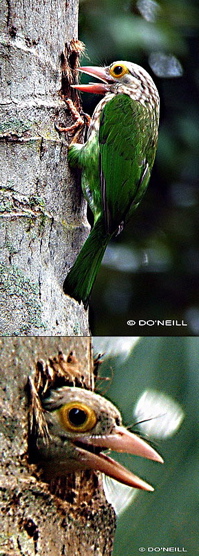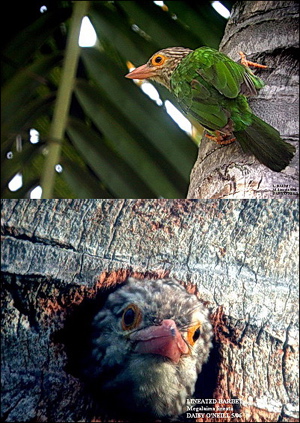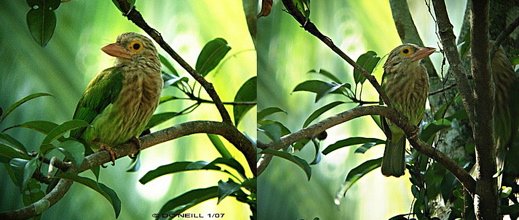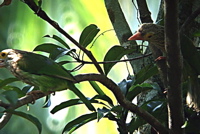While Laurie, the Yellow-vented Bulbul (Pyconotus goiavier) romanced his lady bird with a repertoire of showmanship dancing; Johnny, the randy Coppersmith Barbet’s (Megalaima haemacephala) gambit of a third and free bonk that paid off; what has his bigger cousin, the Lineated Barbet (Megalaima lineata) got to show readers, the varied fascinating courtships and barbets’ behaviour of this avian species?
A well lived-in, modern, Malay village in Northern Peninsula Malaysia is where another unique behaviour was observed.
Within a pocket of inland open-plan, individual kampong-styled houses are cultivated palms and orchards. They thrive side by side, scattering their trees and dividing houses of verandas displaying a variety of outdoor, evergreen potted plants and tropical flowers.
While stumps of old coconut palms were left to rot, those remained standing became condominiums to various species of birds. Old excavated cavities in the trunks bear witnesses to the many generations of barbets and woodpeckers that came and went. When cavities left idle, they became confinement hotels to some birds that do not excavate holes but turned them into low-cost, high-rise, top class squatters.
As shown in the image on the left, one stump in particular caught my attention – one that looks like a giant wind instrument – the recorder. This is the ancestral home of the ubiquitous, Lineated Barbet.
In the open country of semi-deciduous forests of North Malaysian Peninsula, the chances of hearing the echoed calls of the Lineated Barbet ‘Kuk-kroik! Kuk-kroik!’ (second note a fourth higher) is good. Often, a seemingly mate sits unseen, not too far away, would reply in unison – thus giving away the site of his/her perch.
There are 72 worldwide species of mostly green coloured barbets with distinctive head patterns – with the exception of the Brown Barbet (Calorhamphus fuliginosus) whose plumage is virtually all brown. The approximate 29cm Lineated Barbet of imperial jade coloured body-plumage, straw-coloured head and streaked dark-brown upper breast, blend exceedingly well into their living environment. They are difficult to see when remained quietly perched in tree canopies. Such natural camouflage makes Lineated Barbets one of the best and challenging birds to observe and to photograph in the wild.
The heavy bodied and big headed Lineated Barbet is seen to be an intelligent vigilante with precision tactical decoy.
The series of images above show the following sequence of events. Prior to entering excavated nesting hole, the female vigilantly checked for predatory onlookers. Fronting the nesting cavity, she clung the sides of dead trunk with her zygodactylous toes.
The female Lineated Barbet looked right, looked left, rotated her neck to look behind, and with an expression of glee would she thought safe to proceed further.
She delightfully peeped into her new condominium. ‘‘Heloo….Anyone home…?”
Her large dark buttoned eyes, surrounded by a wide, prominent orbital skin, sparkled with approval and satisfaction. Her opened huge, pinkish bill equated to a broad smile of happiness, like a new bride or mistress just been given keys to a new penthouse at West End (right top).
At this stage of writing, I am unable to tell if the excavation of the nesting site was done solely by the male as a gift to the female to inspect for approval or built by both partners. I had witnessed excavation works but unable to tell the sexes apart. They all looked the same.
I chanced upon an opportunity to witness their tactical decoy towards the end of their previous breeding season in June last year. One parent had just finished chick feeding. I then got out of my vehicle. A bird on sentry duty spotted me with my scope. Perched within view of the nest that is no less than 20 feet tall, the sentry raised the alarm calls. ‘Kuk-kroik! Kuk-kroik!’ The parent made for a dash flight away from the nest.
Portia, the parent landed on a living coconut trunk (left top). The chick was nesting in a cavity of dead tree trunk nearb (left bottom). In open view Portia proceeded to pretend drumming the trunk to distract my attention away from the nesting site. Every now and then she would turn around, looked towards my direction to ensure I was watching her performance. She refused to fly off even when I closed in on her. What excellent team work, I thought.
I guess the favourite and pleasurable observation of all avid birders and readers has to be courtship behaviour. Be it courtship dancing or feeding.
By no means has the male Lineated Barbet a long tail with dazzling plumage to dance and display like the Great Argus (Argusiamus argus) pheasant. Neither does the pair exhibit any kind of finesse in courtship feeding behaviour where their ‘table manners’ are left much to be admired.
Two Lineated Barbets were serenading to each other from a shady tree (above). With my scope, I scanned the source of their characteristic song, ‘Ku-tub! Ku-tub’ repeated one verse per second continuously. Eventually, I located Martha. The female barbet was perching on an opened branch.
Monty, the frugivorous male was playing ‘Hide and Seek’ behind a thick branch. He was partially seen by me, but soon got found by Martha. He appeared meekly with a fruity gift for Martha. In that split second, the quick witted Martha, snatched the gift off his beak, did a runner, leaving Monty totally in dismay!
It happened so quickly, the camera and I had no opportunity to pick up that moment. One image however, showed Monty’s dismay as if to say,, ‘Gosh! You don’t waste time do you, woman?’ (right).
As for Martha, the quick witted Barbet, she turned her back on Monty while savouring the gift all to herself.
‘A pleasure to have served you Mam…’ Exit Monty in a dash.
The final analysis. “Is Monty, the male Lineated Barbet being smart or daft?”
SUBMITTED BY DAISY O’NEILL (Avian Writer), PENANG, MALAYSIA.


